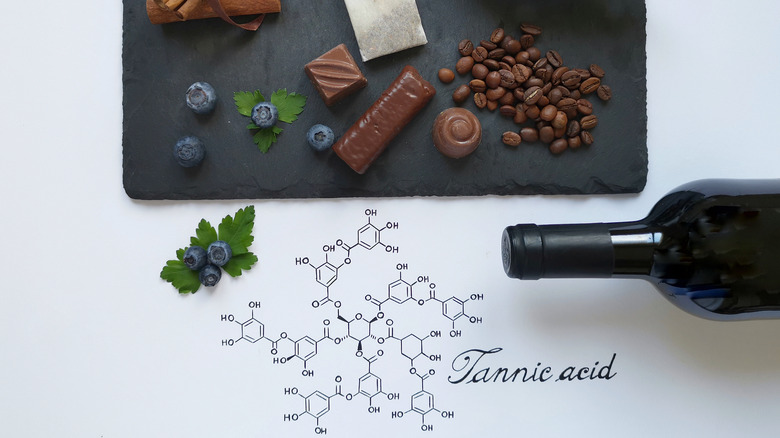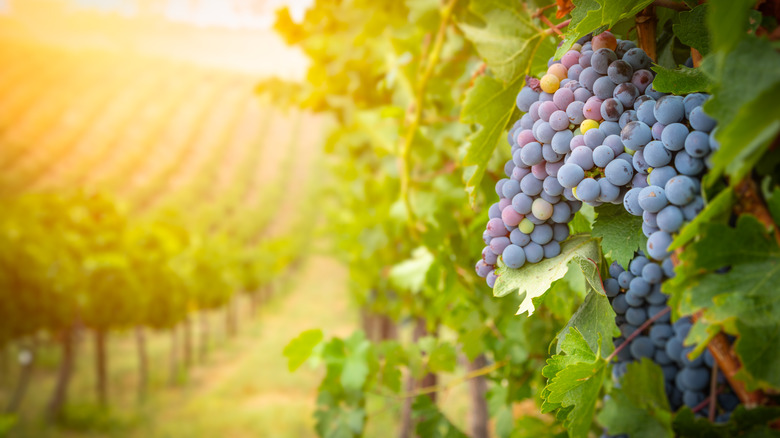Everything You Need To Know About Wine Tannins
Whether you've experienced the drying sensation in your mouth after taking a sip of red wine, or simply heard someone waxing poetic about the level of tannins in a particular wine at a dinner party, chances are you've encountered tannins before. However, many wine drinkers don't really know the particularities of what tannins are, where they even come from, and how they impact a wine.
Now, there's absolutely no reason you need to be able to converse in-depth about tannins in order to enjoy a glass of wine. However, knowing whether you enjoy wines with high or low levels of tannins can help you zero in on a bottle that perfectly suits your palate. It's just another descriptor to aid in your enjoyment of vino. After all, if you're someone who simply enjoys a glass or two after a long week, the whole purpose of having a wine vocabulary is to be able to find out what you like and don't like. When you know your preferences, you can get even better recommendations at your local wine store or from the sommelier at your favorite restaurant.
What tannins really are
On a basic level, tannins are naturally occurring chemical compounds that are found in things such as chocolate, tea, and, of course, wine, according to The Small Winemakers Collection. They can also be found in certain fruits, including rhubarb, pomegranate, and cranberry. Scientifically, tannins are referred to as polyphenols (via Vine Pair), a word you may have heard in connection with various items in the culinary world. In particular, tannins in wine are comprised of two types of phenols: flavonoids and non-flavonoids, per Seven Fifty Daily.
It's the flavonoids in particular that play a big role in the drying, astringent quality that tannins have. They work in your mouth by binding to proteins and creating non-liquid-soluble complexes. In simple terms, they interact with the liquid in your mouth, a.k.a. your saliva, which becomes less effective at lubricating your mouth — hence the dry sensation after you take a sip of a particularly tannic wine.
Curious about the origins of the unusual word? While many associate it most heavily with wine today, centuries ago it was related primarily to "the process of using extracts from plants to cure leather," according to MasterClass, which is known as tanning.
Where do tannins come from?
In the world of wine production, tannins are released from a variety of sources, including the grape skins, grape seeds, and grape stems that go into crafting the perfect bottle (via Seven Fifty Daily). In some cases, The Spruce Eats notes, they can also be found in the oak barrels that producers use to age certain wines. Tannins in a wine develop naturally during the process of growing and production, although there are certain steps winemakers can take to play around with the tannin levels in a wine.
Climate also plays a role in the production of tannins. Grapes grown in cooler climates, and grapes that are picked earlier in their growing process, often have tannins that are structurally a bit smaller, whereas grapes that are grown in warmer climates and picked later in the growing process have larger tannins, which produce a softer effect. While you don't have to know the minutiae of tannin size, it can be helpful to recognize that this is one of the reasons behind the differences in tannins — some smaller tannins are almost unpleasantly bitter, while others have a drying effect that is noticeable but contributes to the wine in a positive way (via Wine Enthusiast), adding a particular mouthfeel that many wine drinkers enjoy.
Do all wines have tannins?
Yes, since the tannins in wine come primarily from the grape stems, skins, and seeds, which are the main components of all wines, every wine technically has tannins present in it. However, the level of tannins within different wines varies widely. Wines in which the grape skins are left on during the production process are likely to be higher in tannins, as Usual Wines notes, which is why as a rule of thumb, red wines are considered to be quite tannic while white wines are not.
Where does rosé factor into the mix? Well, while there are varying levels of boldness in rosé hues, from the palest pinks to vibrant shades that border on red, in general, there is less skin contact in the production process, meaning that rosé tends to have lower levels of tannins (via Wine Spectator). This rule also factors into the tannin level of orange wine, a trending new category that many wine drinkers are exploring. Orange wines receive their signature hue because winemakers use white grapes but produce the wine in the way they'd typically produce a red, keeping the skins in the mix, hence the unusual color in the glass, according to Vine Pair. The presence of the grape skins, one of the primary sources of tannins, means that orange wines are generally more tannic than whites, despite being made from the same type of grapes. It's all about how long those skins, stems, and seeds linger in the mix!
Wines that are high (and low) in tannins
Simply put, red wines will nearly always have higher levels of tannins. However, just as there is a vast difference between a lighter-bodied red like Gamay and an inky, bold wine such as a Petite Sirah, there are different levels of tannins within the category of red wine. Two of the most tannic reds, according to Wine Folly, are Tannat and Sagrantino. Both have big, bold flavors, paired with equally strong levels of tannins. A few other tannic choices include Nebbiolo, Cabernet Sauvignon, Petit Verdot, and Monastrell.
Don't fret if you're a lover of red wine and not a fan of strong tannins, though — there are plenty of bottles on the market that are perfect for your palate. Often, red wines that are described as very fruity, and which are a bit lighter in color, have lower levels of tannins. Options for those seeking a less tannic red include Gamay, Valpolicella, Frappato, Cinsault, Carignan, and Barbera, or if you're looking for something with a bit of sparkle, Lambrusco. Finding wines that are aged in steel rather than in oak, which can add a healthy dose of tannins to the wine, can also be helpful. Another rule of thumb if you know a bit about aging? A red that you'd consider drinking young tends to be less tannic, whereas something that is a great candidate for aging likely has more tannins (via Wine Spectator).
Are tannins in wine bad for you?
It's natural to wonder if the bitter taste and astringent effect of certain highly tannic wines has an impact on your health, but actually, tannins are an antioxidant, per Wine Folly. It's why wines that are high in tannins are particularly suited for aging, Vine Pair says, as the tannins within the wine actually help to protect it during the aging process.
There is, however, one negative way that tannins can impact certain wine consumers — headaches. Some wine drinkers experience headaches after enjoying a glass or two, and though there are a variety of reasons that could trigger that throbbing sensation in your head, tannins might be one of them. According to Healthline, tannins cause your body to release serotonin, and the reaction could potentially lead to headaches. If you're unsure as to whether it's the tannins in the wine provoking your headache or something else, one of the best ways to gauge your personal sensitivity to tannins is to try out other foods that contain high levels of tannins, such as dark chocolate and strong black tea (via MasterClass). This can help you determine if it's the tannins setting off your headache or migraines, or something else. If you have a particular sensitivity to tannins, you certainly don't have to give up red wine, but you may find your head thanks you for sipping white wine or at the very least, a red on the lower end of the tannic spectrum.





